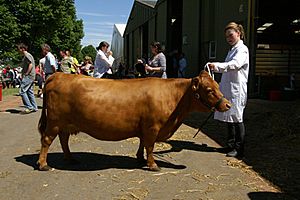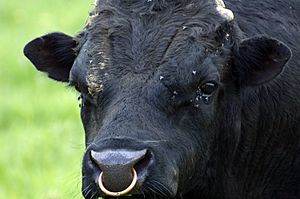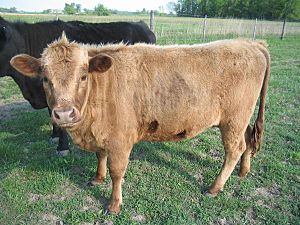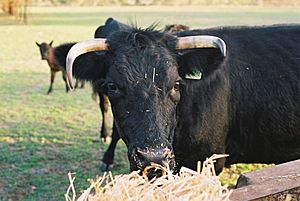Dexter cattle facts for kids
Dexter cattle are a special type of cow from Ireland. They are the smallest cows in Europe! Imagine a cow that's only half the size of a regular Hereford cow, or even smaller than a Holstein dairy cow. Not long ago, these cows were quite rare. But now, more people are raising them, and they are considered a 'recovering breed' by the Livestock Conservancy.
Contents
History of Dexter Cattle
The Dexter cow first came from southwestern Ireland. They were brought to England in 1882. For a while, they almost disappeared in Ireland. However, small groups of these purebred cows were kept safe in England and the United States.
Dexter cows are quite small. Adult cows usually weigh between 600 and 700 pounds. Adult bulls can weigh around 1,000 pounds (450 kg). Even though they are small, their bodies are wide and strong. They have well-rounded back ends.
What Do Dexters Look Like?
Dexter cattle come in three main colors:
- Black
- Red
- Dun (a brownish color)
They usually don't have white markings. Sometimes, you might see a little white on their belly or udder. A few white hairs can also be found on the end of their tail.
Many Dexters have horns. These horns are usually small and thick. On male Dexters, the horns grow outwards and curve forward. On female Dexters, they grow upwards. Some Dexters are naturally hornless, which means they are born without horns.
Dexters are good for producing both meat and milk. Some farmers choose to focus on one or the other.
Amazing Traits of Dexter Cattle
Dexter cattle are known for being small and friendly. They are called a "dual-purpose" breed because they give both milk and beef. Some people even call them "triple-purpose" because they can also be used as oxen to pull things.
Their ability to do many jobs is a big reason why they are found in so many places. You can find Dexter cattle in North America, South Africa, Australia, and many parts of Europe.
Dexter Beef and Milk
In the United States, Dexter cows raised for meat are ready in about 18 to 24 months. They provide small cuts of high-quality, lean meat. This meat is usually well-marbled, meaning it has small streaks of fat. It also tends to be a darker color.
Dexter cows produce rich milk. This milk has a good amount of butterfat (about 4%). The quality of their milk is similar to that from Jersey cattle. A Dexter cow can produce about 1.5 to 2.5 gallons (7.6 to 9.5 liters) of milk each day.
Great Mothers and Easy Calving
Dexter cows are amazing mothers. They often hide their calves almost right after they are born, especially if there's a good place to hide. Some Dexter mothers produce enough milk to feed two or even three calves! They are also known to willingly nurse calves from other cows.
Dexters are famous for having easy births. This means the mother cow usually doesn't have trouble when her calf is born. Because of this, some farmers use Dexter bulls to breed with larger cows. This helps the larger cows have an easier time giving birth to their first calf.
Special Features of Dexters
Some Dexter cattle carry a special gene. This gene can cause a type of dwarfism called chondrodysplasia. Cows with this gene have shorter legs than other Dexters. They are usually about 6 to 8 inches (15 to 20 cm) shorter.
Dexter cattle originally had horns. But in the 1990s, a type of Dexter was developed that is naturally polled. This means they are born without horns.
Dexter cattle have shorter legs compared to many other cow breeds. Their legs are shorter from the knee down to the fetlock (the joint above the hoof).
These cows are very tough and good at grazing. They can even do well on land that isn't very rich.
Growing Popularity of Dexters
Dexter cattle were once very rare in both the United Kingdom and the United States. But now, they are becoming popular again! In 2007, over 4,100 Dexter cows were registered in the UK. This was double the number from 2000.
Many people are choosing Dexters because they want to produce their own food. This is especially true with higher food prices. Sue Farrant, who owns four Dexters, said, "They do largely look after themselves and they've been hugely popular with the children."
The popularity of Dexters has grown for several reasons:
- People want more organic food.
- They are concerned about factory farming methods.
- Food prices are rising.
Poet and songwriter Pam Ayres has a small group of Dexters on her 20-acre (81,000 m2) property in the Cotswolds. She said, "If you've got a bit of land, a breed like the Dexter can work out a lot cheaper than the supermarket, plus they do a pretty good job of mowing the lawn."






